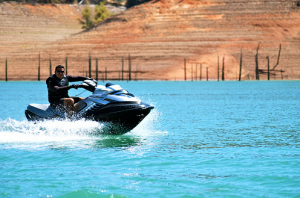While you should always be aware of your surroundings when you’re at the helm, you should be on full alert whenever you’re entering an area with shallow or “skinny” water. Whether it’s an area that’s filled with boat-crunching coral like Key West or a muddy tributary to the Mississippi River, a cavalier attitude can get you grounded, stuck or worse. But with a little common sense and the following tips, you can boldly cruise skinny water with confidence.
1. Check The Soundings
Although boat electronics were once priced out of the reach of many average boaters, today there are lots of reasonably priced devices out there to help in shallow-water situations. For most folks, it will be a depth finder. But if your conditions are extreme, it makes sense to consult a chart…either electronic or paper. They contain valuable information called “soundings” that show the depths of any particular area you may be traveling. What you’re really looking for are the areas where the water suddenly gets shallower. Steer clear of those areas.
2. Know Your Limits
By all means, know your boat’s draft. That’s a number, normally measured in inches, that tells you how much of your boat is underwater, from the lowest part of your boat up to the waterline. The easiest (and most accurate) way to get this information is from your owner’s manual or the boat manufacturer’s website. In a pinch, you can estimate this number by dividing the overall length (measured from bow to stern at the waterline) by two. Keep in mind that unless you’ve got a jet drive, you’ll also have a spinning prop or two at about that depth, so always trim up when things start to get shallow.
3. Read The Water
This is where those high-tech polarized sunglasses really earn their keep. As you’re underway, you’ll be able to see a variety of different colors under the water. Look for drastic changes in color, and always be aware that darker usually means deeper. Some parts of the country have little jingles to help you remember such as: Brown, brown, run aground. White, white you just might. Green, green, nice and clean. Blue, blue, sail on through.
4. Know The Tides
Even if you got through some skinny water yesterday without incident, you always need to check the tide schedule before trying it again. Many coastal areas deal with a significant tidal change of up to several feet, making low tide extremely treacherous when you’re shoving off. Worse still, you could snake your way to some great flats fishing, then find yourself stranded for hours until the tide comes back in. Don’t let this happen to you!
5. Slow Down
Unless you’re cruising on a pontoon, more than likely your boat has what’s called a “planing hull.” That means it will sit lower in the water until you reach an “on-plane” speed, which is different for every boat. Once on plane, your boat will lift and rise up out of the water, giving you a little more shallow-water clearance from the bottom. The problem is, if you’re running at planing speed and suddenly come up on a shallow area, your reaction will likely be to pull the throttle back completely. That can run you aground (as the boat drops off plane) or worse. Just run slowly and stay off plane if there’s a chance of shallow water. Better to bump something and be able to back off gently than run aground hard and risk damage to you, your passengers or your boat.
